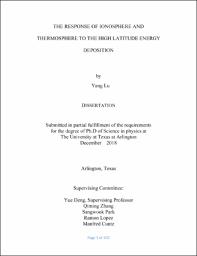
ATTENTION: The works hosted here are being migrated to a new repository that will consolidate resources, improve discoverability, and better show UTA's research impact on the global community. We will update authors as the migration progresses. Please see MavMatrix for more information.
Show simple item record
| dc.contributor.advisor | Deng, Yue | |
| dc.creator | Lu, Yang | |
| dc.date.accessioned | 2019-02-26T21:03:34Z | |
| dc.date.available | 2019-02-26T21:03:34Z | |
| dc.date.created | 2018-12 | |
| dc.date.issued | 2018-12-10 | |
| dc.date.submitted | December 2018 | |
| dc.identifier.uri | http://hdl.handle.net/10106/27771 | |
| dc.description.abstract | The ionosphere and thermosphere are the important regions in the Earth upper atmosphere. They represent the ionized and neutral particles, respectively. The main external energy sources in those regions are solar radiation and geomagnetic energy due to the solar wind-magnetosphere interaction. The neutral particles are ionized by solar radiation on the dayside. Meanwhile, the energy deposition from the magnetosphere is also critical at high latitudes.
The energy source at high latitudes depends on whether the local magnetic field line is closed or not. In the polar cap region where it is connected to open magnetic field line, the main energy source is from solar wind or the magnetosheath. In the aurora region where it is related to the closed field line, the main energy source is from magnetotail. The Poynting flux and particle precipitation are two kinds of energy sources at high latitudes. Energy deposition at high latitudes influences the ionization and electrodynamics in the upper atmosphere, which has practical importance since the ionization particles in the upper atmosphere influence the radio propagation significantly. Therefore, the high latitude ionosphere and thermosphere are the most dynamic regions in the upper atmosphere since the different kinds of energy deposition.
In this work, the energy deposition and the ionosphere/thermosphere response at the high latitudes have been studied. First, Constellation Observing System for Meteorology, Ionosphere, and Climate (COSMIC) electron density profiles are used to study the conductance at different altitudes. Ionospheric conductivity plays an important role in the magnetosphere-ionosphere coupling. The altitudinal distribution of Pedersen conductivity gives us a rough idea about the altitudinal distribution of Joule heating at high latitudes, which is of great significance regarding the response of upper atmosphere to geomagnetic energy inputs. Based on the electron density profiles derived from the COSMIC measurements during 2009–2014, Pedersen conductivity has been estimated. A climatologic study of the height-integrated Pedersen conductivity in
both E (100–150 km) and F (150–600 km) regions, and their ratio under different solar and geomagnetic conditions has been conducted.
Second, the Poynting flux and particle precipitation data from DMSP F15 are used to study the energy deposition in the polar cap boundary regions. Poynting flux, which describes electromagnetic energy flux, is an important energy source for the high-latitude upper atmosphere. After the launch of Defense Meteorological Satellite Program (DMSP) F15 spacecraft with a boom-mounted magnetometer on board, there was a new opportunity to calculate Earth-directed Poynting flux at satellite altitudes (~850 km) in the upper atmosphere. A persistent enhancement of thermospheric density in the dayside polar cap boundary regions has been reported in the CHAMP satellite observations. To understand the significance of different physical mechanisms including Poynting flux and particle precipitation, and the correlation between them, a statistical study of Poytning flux and particle energy flux in the dayside cusp and low-latitude boundary layer (LLBL) regions has been conducted based on DMSP F15 measurements.
At last, the Global Ionosphere and Thermosphere Model (GITM) are used to study the response to the geomagnetic storm event. Ion velocity in the Sub Aurora region observed by Satellites in storm time often shows a significant westward component. The high-speed westward stream is distinguished with convection pattern. This kind of events is called Sub Aurora Polarization Stream (SAPS). In March 17th 2013 storm, DMSP F18 satellite observed several SAPS cases when crossing Sub Aurora region. In this study, Global Ionosphere Thermosphere Model (GITM) has been coupled to UCLA-RCM model to simulate the impact of SAPS during March 2013 event on the ionosphere/ thermosphere. | |
| dc.format.mimetype | application/pdf | |
| dc.language.iso | en_US | |
| dc.subject | Energy deposition | |
| dc.subject | Poynting flux | |
| dc.subject | Particle precipitation | |
| dc.subject | Ionosphere | |
| dc.subject | Thermosphere | |
| dc.title | THE RESPONSE OF IONOSPHERE AND THERMOSPHERE TO THE HIGH LATITUDE ENERGY DEPOSITION | |
| dc.type | Thesis | |
| dc.contributor.committeeMember | Cuntz, Manfred | |
| dc.degree.department | Physics | |
| dc.degree.name | Doctor of Philosophy in Physics and Applied Physics | |
| dc.date.updated | 2019-02-26T21:03:35Z | |
| thesis.degree.department | Physics | |
| thesis.degree.grantor | The University of Texas at Arlington | |
| thesis.degree.level | Doctoral | |
| thesis.degree.name | Doctor of Philosophy in Physics and Applied Physics | |
| dc.type.material | text | |
Files in this item
- Name:
- LU-DISSERTATION-2018.pdf
- Size:
- 13.33Mb
- Format:
- PDF
This item appears in the following Collection(s)
Show simple item record


